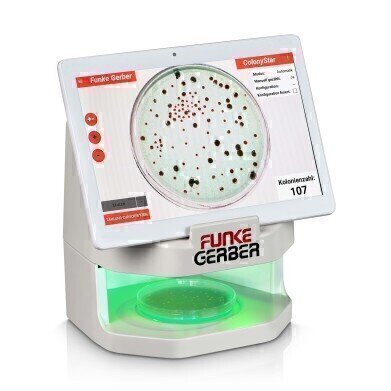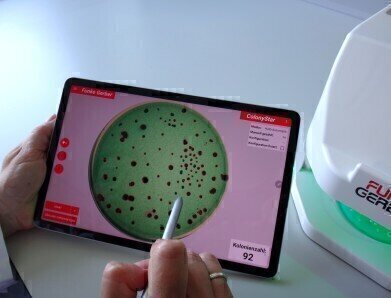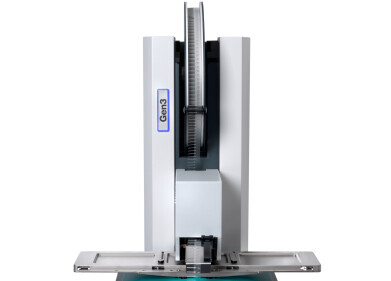-
 The intelligent, intuitive ColonyStar system is suitable for all Petri dishes up to a maximum diameter of 9.5 cm (3.7 inches) and can be used in all microbiology laboratories, such as in the food industry, but also in medicine, research, veterinary medicine, or in public administrative bodies, such as environmental authorities. Source: Funke-Dr. N. Gerber Labortechnik GmbH
The intelligent, intuitive ColonyStar system is suitable for all Petri dishes up to a maximum diameter of 9.5 cm (3.7 inches) and can be used in all microbiology laboratories, such as in the food industry, but also in medicine, research, veterinary medicine, or in public administrative bodies, such as environmental authorities. Source: Funke-Dr. N. Gerber Labortechnik GmbH -
 Individual colonies can be marked by tapping on them on the screen with your finger or a touchscreen stylus. In the assist mode, other colonies of the same type are now identified, marked, and counted. Source: Funke-Dr. N. Gerber Labortechnik GmbH
Individual colonies can be marked by tapping on them on the screen with your finger or a touchscreen stylus. In the assist mode, other colonies of the same type are now identified, marked, and counted. Source: Funke-Dr. N. Gerber Labortechnik GmbH
Laboratory Products
Speed Up Your Colony Counting: Unique system automatically identifies colony type and count
Dec 13 2021
No more time-consuming counting by hand
Regular colony counts are part of the day-to-day tasks of many laboratories in order to rule out the contamination of products with bacteria, viruses, yeasts, or moulds during production. To do this, Petri dishes containing the relevant samples are evaluated in order to determine the number of colonies formed. While the classic manual counting method means that every single colony has to be marked individually, automatic devices can analyse numerous Petri dishes of the same type very quickly. However, this requires time-consuming programming and preparation that may not be feasible if there is a small batch of samples.
Automatically identify colonies of the same type and count colonies in just a few clicks
As of June 2021, help is at hand with the ColonyStar automatic from Funke-Gerber. The device, which is equipped with a camera and a cordless, detachable tablet makes the analysis of Petri dishes both fast and straightforward. The unique assist mode is particularly helpful: After tapping on a colony via touchscreen, other colonies of the same type are automatically recorded, marked, and counted. The selection can be corrected at any time. The lab worker retains full control while also achieving huge time savings.
In order to mark 200 colonies, for example, only between four and 15 actions are necessary. The system can still be trained to identify selected colonies so that fully automatic colony counts can be conducted on predefined samples. Therefore, one can analyse ten to 15 Petri dishes containing the same species on the same agar media and then, after the learning phase, save it as a profile, such as Salmonella. Colonies of the same type that match these can then be analysed fully automatically.
More information online
Digital Edition
ILM 49.5 July
July 2024
Chromatography Articles - Understanding PFAS: Analysis and Implications Mass Spectrometry & Spectroscopy Articles - MS detection of Alzheimer’s blood-based biomarkers LIMS - Essent...
View all digital editions
Events
Jul 20 2024 Denver, CO, USA
Jul 21 2024 Cape Town, South Africa
Jul 28 2024 San Diego, CA USA
Jul 30 2024 Jakarta, Indonesia
Jul 31 2024 Chengdu, China
.jpg)






.jpg)
24_06.jpg)








